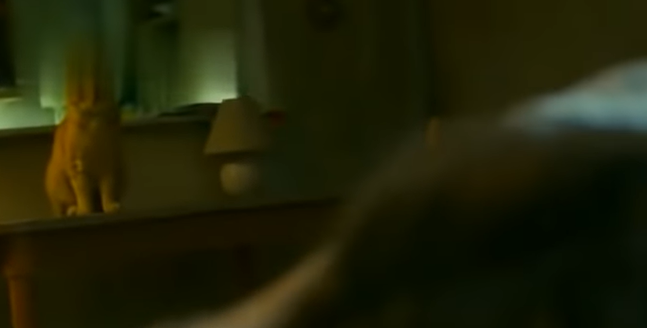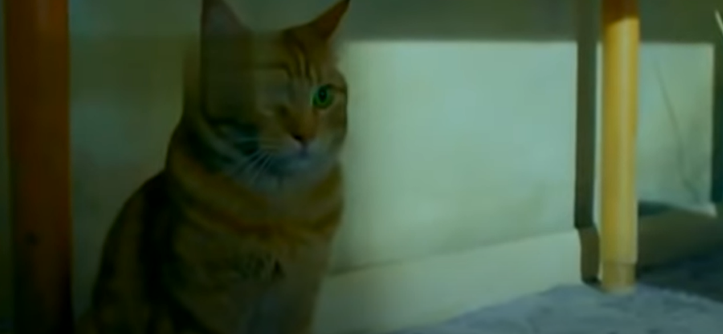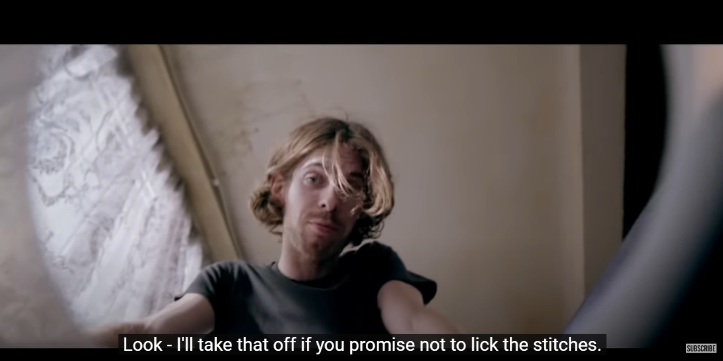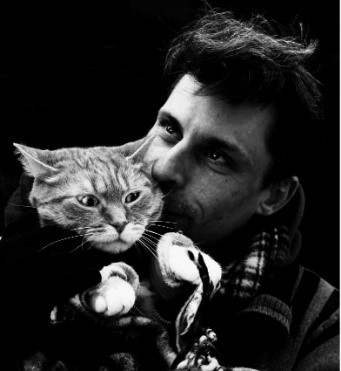[1]
A Street Cat Named Bob is a 2016 biographical drama directed by Roger Spottiswoode. The film is based on an memoir of the same name, which narrates the true story of James Bowen, a British man who struggled with homelessness and heroin addiction, who attributes his recovery to a stray cat he named Bob. According to the film, Bob appeared in Bowen’s life as he was allocated housing and beginning his journey to sobriety. A ‘homeless’ stray himself, Bob seems to ‘adopt’ Bowen, providing mutual aid and support. Spottiswoode’s interpretation of the story is a ‘heart-warming’ tale about the familial role that pets play in the lives of humans, focusing especially on their importance to homeless people who often depend on them as companions and “lifesavers”.
As a biographical drama, A Street Cat Named Bob provides a specific kind of redemptive narrative, tracking the progress of Bowen’s journey from homeless heroin addict to sober author and inspiration. A review for the film states, “This is the sort of film that you’ll either find dangerously mawkish or utterly charming”, indicating its emphasis on sentimentality and its attempt to portray a ‘heart-warming’ tale through a focus on the disenfranchised. [2] Therefore, it seems significant to consider why this story in particular, out of countless other stories of homeless people struggling with addiction and recovery, became so famous and widespread that it was turned into a film. It seems apparent that the interest and compassion that Bowen’s story evokes is down to his relationship with Bob, as people can sometimes possess more empathy for homeless lives when they are also responsible for the life of an animal. For example, Figure.0.2. is a Channel 4 News interview with British homeless people who own animals. At the 3:30 minute mark, one of the interviewees states, “Ninety-nine percent of people give me money for the dog”, highlighting the role of homeless people’s animal companions in evoking concern and aid from the general public.[3] However, it is important to note that this is not always the case, and homeless people with pets are often disadvantaged when it comes to housing.
Leslie Irvine’s research into the role of pets in the ‘redemption’ narratives of homeless people highlights much of the film’s preoccupations. For example, Irvine states, “Stories of redemptive commitment to pets can circulate only in a time and place that honors such relationships and grants animals nearly divine powers or at least does not rule them out.” [4]
The idea that today’s society grants animals “divine powers” is an apt observation when considering Bob’s role and representation within the film. During a sequence in which James is attempting to detox from his heroin use, Bob consistently lingers in the background of the film, an omniscient and calm presence which watches over James as he vomits and screams. The camera is positioned in such a way as to present the scene from James’ perspective, distortion and an out of focus lens demonstrate the mental and physical pain that he is undergoing during this withdrawal. However, the camera always gradually focuses back in on Bob in the background, as James is reminded of his presence observing and watching over him, presenting him as a silent saviour in line with the idea of a ‘guardian angel’. This highlights the idea that pets are often held in high regard by humans as almost “divine” beings capable of changing and saving the lives of their human owners. This idea of domesticated pet animals as holding so much importance within British society is expanded upon during another scene, in which Bob follows James onto a bus, garnering endearing smiles and touches from the passengers. He sits with James at the top of the bus, gazing out at London from a height. As the bus passes Nelson’s Column in Trafalgar square, Bob’s silhouette is aligned with one of the Landseer Lions, as James tells him, “yeah, you’re a lion”. This seems significant if you consider the figure of the lion as a British national symbol, held in reverence and high regard with around 10,000 lion monuments in London alone. [5] Here, Bob as pet and companion is transformed into a figure of national importance, reflecting the attitudes of society towards these kind of animals.

Fig.0.3 Bob watches over James during his heroin withdrawal 
Camera perspective is further utilised throughout the film to present the perspective and gaze of Bob himself. According to Jonathan Burt film often exploits this animal gaze to effectively turn the animal into “a camera, a non-human recording mechanism”. [6] In one specific scene this occurs after an operation, where Bob is made to wear a cone which he does not take to. The camera is positioned from within the cone, presenting Bob’s perception of James as he tells him, “Look I’ll take it off if you promise not to lick the stitches”. Here, he demonstrates his concern for Bob’s comfort and happiness, addressing him as though he is a human. The fact that this is presented through Bob’s gaze is significant and links to the commonly shared idea that animals are a “good judge of character”. [7] It is therefore, through the animal that James is humanised and moralised, depicted as a good and empathetic character which the viewer can relate to, especially if they themselves have pets

Fig.0.4. Bob watches as James addresses him
Spottiswoode’s use of lighting and colour within the film further emphasises the positive impact of animals on the lives of the homeless. Throughout the film’s opening scene the viewer is confronted with the image of Bowen overdosing in a dark, desolate and uncaring London street. He receives no help, no sympathy and the mise-en-scene reflects this. However, when Bob is introduced, the film becomes brighter and more optimistic, full of colours other than the grey streets of the opening scene. Whilst this definitely reflects the optimism and hope that has entered James’ life now that he has a companion and a sense of responsibility, something to remain sober for, there is also a subversive element to this which reflects the changed public perception and opinion of James now that he is busking with a ‘cute’ cat on his shoulders. “Arluke and Levin concluded that species is important when it comes to generating sympathy with the downtrodden” [8] This can be seen in Figure 5, a photo taken from photography series, Humanising the Homeless. This example illustrates Arluke and Levin’s conclusion that the presence of animals alongside the “downtrodden” and marginalised can often evoke more sympathy from the public, who view their commitment and relationship with the animals as an indicator of their kindness, morality and humanity, in turn, influencing their general perception of the human individual.

Fig. 0.5. Image from photography series, Humanising the Homeless
Following on from this idea, Spottiswoode includes a series of juxtapositions within the film to represent James’ life pre and post Bob. Many of these focus on the reactions of the public during his time busking on the street. A scene from the beginning of the film features James playing a song on the street, he is met with cold glares or otherwise dismissed and ignored. This same song is played later in the film when Bob has entered his life and joins him on his busking. Here, the reactions from the public are entirely different, people are smiling, engaging and standing around to listen. Here, Spottiswoode uses the same song to create continuity, demonstrating that the only thing that has changed is the presence of Bob in James’ life, attributing his increased success to the public interest in the ‘cute’ cat wearing a striped scarf. This is further emphasised through, again, the utilisation of Bob’s gaze. The reactions of the people are not directed toward James, but are instead focused on Bob, subtly indicating that despite the increased positive attention, James is still being ignored and dismissed as he was at the beginning of the film.
“A third factor that makes animals appropriate for redemption narratives involves our imaginations of them as innocents. Animals do not judge the disabled, the former addict, the ex-con, or the prostitute. They stand as silent witnesses to our behavior.” [9] Ultimately, the film utilises and exploits the innocence of animals in order to “humanise the homeless”, utilising the non-judgemental gaze of the non-human to portray Bowen as empathetic and caring, encouraging support and concern for his situation as homeless drug addict. However, the popularity and attention that Bowen’s story generated amongst the public, demonstrates the idea that humans often care more for animal life than marginalised human life, an idea that Spottiswoode conveys by elevating Bob to a “divine” being, held in high regard by the human population. Therefore, the film not only portrays the importance of animal companions to the homeless population and the role of pets as companion and lifesaver, but the very fact that this story in particular was selected for a ‘heart-warming’ biographical film about this marginalised community highlights the idea that pets and domesticated animals in particular are often ‘humanised’ more than disadvantaged humans, and therefore, serve as a tool in portraying the humanity of those who are so often denied it. Whilst the film’s premise generally does enforce this trope, the subtle subversions reflect this concern back towards the viewer, indicating the problematic nature of this phenomena.
Further Reading:
Home is where their dog is (2018) https://themayhew.org/homeless/
Leslie Irvine, My Dog Always Eats First: Homeless People and Their Animals (Boulder, CO: Lynne Rienner Publishers, 2015).
Jack Levin and Arnold Arluke, ‘Are People More Disturbed by Dog or Human Suffering? Influence of Victim’s Species and Age’, Society and Animals, 25.1, (2017), 1-16
The One Show, 2016. The One Show With James Bowen And His ‘Streetcat’ Named Bob ! – 24Th Oct 2016. Available at: <https://www.youtube.com/watch?v=hpaYPSTHFUA&t=132s> [Accessed 1 June 2020]
Bibliography
Burt, Jonathan Animals in Film (London: Reaktion Books, 2012)
Channel 4 News, 2017. Dogs On The Streets: How Four-Legged Friends Help The Homeless. Available at: <https://www.youtube.com/watch?v=RUaEDuxAVhY> [Accessed 1 June 2020]
Constantinou, Anton, LIONS OF LONDON: 6 OF THE MOST FAMOUS LION STATUES IN LONDON (2018)<https://www.silverdoorapartments.com/blog/lionsoflondon/#:~:text=Take%20a%20look%20at%20how,these%20six%20beautiful%20lion%20sculptures.> [accessed 1 June 2020]
Herzog, Hal Why People Care More About Pets Than Other Humans (2015) <https://www.wired.com/2015/04/people-care-pets-humans/> [accessed 1 June 2020]
Irvine, Leslie ‘Animals as Lifechangers and Lifesavers: Pets in the Redemption Narratives of Homeless People’, Journal of Contemporary Ethnography, (2013), 3-30
Mottram, James, Film review: A Street Cat Named Bob – true story of addict and feline will warm the heart (2017) <https://www.scmp.com/culture/film-tv/article/2058219/film-review-street-cat-named-bob-true-story-addict-and-feline-will> [accessed 1 June 2020]
Movieclips Trailers, 2016. A Street Cat Named Bob Official Trailer #1 – Joanne Froggatt, Luke Treadaway Movie HD. Available at: <https://www.youtube.com/watch?v=s13Fnj8LzD8> [Accessed 1 June 2020]
Wu, Sharon Humanizing the homeless: Teen’s portraits shed light on life on the streets (2017) <https://www.cbc.ca/news/entertainment/humanizing-the-homeless-teen-s-portraits-shed-light-on-life-on-the-streets-1.4189757> [accessed 1 June 2020]
NOTES
[1] Movieclips Trailers, 2016. A Street Cat Named Bob Official Trailer #1 – Joanne Froggatt, Luke Treadaway Movie HD. Available at: <https://www.youtube.com/watch?v=s13Fnj8LzD8> [Accessed 1 June 2020].
[2] James Mottram, Film review: A Street Cat Named Bob – true story of addict and feline will warm the heart (2017) <https://www.scmp.com/culture/film-tv/article/2058219/film-review-street-cat-named-bob-true-story-addict-and-feline-will> [accessed 1 June 2020].
[3] Channel 4 News, 2017. Dogs On The Streets: How Four-Legged Friends Help The Homeless. Available at: <https://www.youtube.com/watch?v=RUaEDuxAVhY> [Accessed 1 June 2020].
[4] Leslie Irvine, ‘Animals as Lifechangers and Lifesavers: Pets in the Redemption Narratives of Homeless People’, Journal of Contemporary Ethnography, (2013), 3-30.
[5] Anton Constantinou, LIONS OF LONDON: 6 OF THE MOST FAMOUS LION STATUES IN LONDON (2018) <https://www.silverdoorapartments.com/blog/lionsoflondon/#:~:text=Take%20a%20look%20at%20how,these%20six%20beautiful%20lion%20sculptures.> [accessed 1 June 2020].
[6] Jonathan Burt, Animals in Film (London: Reaktion Books, 2012), p. 54.
[7] Irvine.
[8] Sharon Wu, Humanizing the homeless: Teen’s portraits shed light on life on the streets (2017) <https://www.cbc.ca/news/entertainment/humanizing-the-homeless-teen-s-portraits-shed-light-on-life-on-the-streets-1.4189757> [accessed 1 June 2020].
[9] Hal Herzog, Why People Care More About Pets Than Other Humans (2015) <https://www.wired.com/2015/04/people-care-pets-humans/> [accessed 1 June 2020].